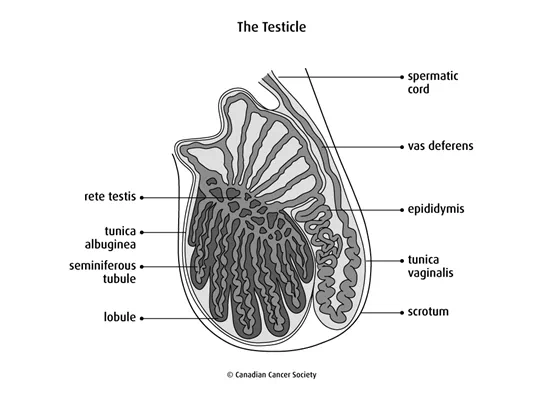Stages of testicular cancer
Staging describes or classifies a cancer based on how much cancer there is in the body and where it is when first diagnosed. This is often called the extent of cancer. Information from tests is used to find out the size of the tumour, which parts of the organ have cancer, whether the cancer has spread from where it first started and where the cancer has spread. Your healthcare team uses the stage to plan treatment and estimate the outcome (your prognosis).
The following staging information is for germ cell tumours of the testicle, which make up more than 90% of all testicular cancers. The most common staging system for testicular cancer is the TNM system. For testicular cancer there are 4 stages – stage 0 followed by stages 1 to 3. Often the stages 1 to 3 are written as the Roman numerals I, II and III. Generally, the higher the stage number, the more the cancer has spread. Talk to your doctor if you have questions about staging.
When describing the stage, doctors may use the words local, regional or distant. Local means that the cancer is only in the testicle and has not spread to other parts of the body. Regional means close to the testicle or around it. Distant means in a part of the body farther from the testicle.

To help stage testicular cancer, doctors also test the levels of certain tumour markers in the blood after surgery to remove the testicle (called orchiectomy). When tumour marker levels are higher than normal in stage 1, this stage of cancer includes an S, given as stage 1S.
Find out more about staging cancer and tumour marker testing for testicular cancer.
Stage 0 (carcinoma in situ)
There is a precancerous condition in the testicle called germ cell neoplasia in situ. It is also called intratubular germ cell neoplasia.
Stage 1A
The tumour is in the testicle and epididymis but may have spread to the inner layer of the membrane that surrounds the testicle (tunica albuginea). All tumour marker levels are normal.
Stage 1B
The tumour is one of the following:
- It is in the testicle and the epididymis and has spread to the blood vessels or lymph vessels in the testicle.
- It has grown into the outer layer of the membrane that surrounds the testicle (tunica vaginalis).
- It has grown into the spermatic cord or the scrotum and may have spread to the blood vessels or lymph vessels in the testicle.
All tumour marker levels are normal.
Stage 1S
The tumour is found anywhere within the testicle, spermatic cord or scrotum, and 1 or more tumour marker levels are higher than normal.
Stage 2A
The cancer has spread to 1 or more lymph nodes in the groin, and they are not larger than 2 cm. Tumour marker levels may be slightly higher than normal.
Stage 2B
The cancer has spread to 1 or more lymph nodes in the groin, and they are between 2 and 5 cm. Tumour marker levels may be slightly higher than normal.
Stage 2C
The cancer has spread to 1 or more lymph nodes in the groin, and they are larger than 5 cm. Tumour marker levels may be slightly higher than normal.
Stage 3A
The cancer has spread to lymph nodes outside of the groin or to the lungs (called distant metastasis). This is also called metastatic testicular cancer. One or more tumour marker levels may be slightly higher than normal.
Stage 3B
The cancer has spread to 1 or more lymph nodes in the groin, and 1 or more tumour marker levels are moderately higher than normal.
OR
The cancer has spread to lymph nodes outside of the groin or to the lungs. This is also called metastatic testicular cancer. One or more tumour marker levels are moderately higher than normal.
Stage 3C
Any of the following:
- The cancer has spread to lymph nodes in the groin, and 1 or more tumour marker levels are much higher than normal.
- The cancer has spread to lymph nodes outside of the groin or to the lungs. This is also called metastatic testicular cancer. One or more tumour marker levels are much higher than normal.
- The cancer has spread to a distant part of the body other than lymph nodes or the lungs. One or more tumour marker levels may be higher than normal.
Relapsed testicular cancer
Relapsed testicular cancer means that the cancer has come back after it has been treated. If it comes back in the same place that the cancer first started, it’s called local relapse. If it comes back in tissues or lymph nodes close to where it first started, it’s called regional relapse. It can also recur in another part of the body. This is called distant metastasis or distant relapse.
